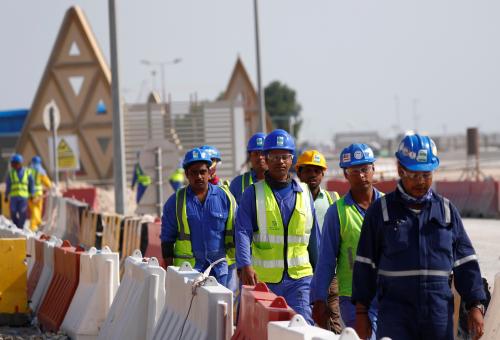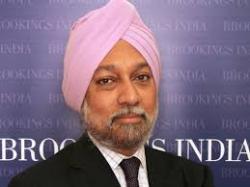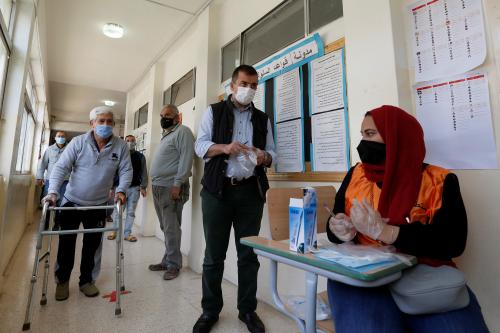

1:00 am AST - 2:30 am AST
Past Event
Content from the Brookings Doha Center is now archived. In September 2021, after 14 years of impactful partnership, Brookings and the Brookings Doha Center announced that they were ending their affiliation. The Brookings Doha Center is now the Middle East Council on Global Affairs, a separate public policy institution based in Qatar.
The Brookings Doha Center (BDC) hosted a panel discussion on March 12, 2017, which examined the burgeoning relationship between India and the Middle East. The panel included Zahra Babar, director of research at the Center for International and Regional Studies at Georgetown University; Waheguru Pal Singh Sidhu, nonresident senior fellow at the Brookings Institution; and Kadira Pethiyagoda, visiting fellow at the BDC. Adel Abdel Ghafar, a visiting fellow at the BDC, moderated the discussion, which was attended by members of Doha’s diplomatic, academic, and media communities.
Abdel Ghafar opened the discussion by giving a brief overview of India’s foreign policy from its colonial period to the present. According to some estimates, during the 18th century, under British rule, India commanded a 23 percent share of the global economy. In the post-colonial period, after 1947, that share shrank to roughly 4 percent. Currently, India represents the United Kingdom’s second-largest trading partner, as well as one of its largest investors—through its ownership of several popular British brands.
Despite the rosy economic outlook, Abdel Ghafar asserted that India still has several issues that it needs to address. It continues to grapple with domestic problems that affect educational programs, health programs, water scarcity, rapid urbanization, and government transparency. On an international level, it struggles with a rising China, a contentious relationship with Pakistan, and managing its relationships with Saudi Arabia, Iran, and Israel—three countries that demonstrate an adversarial relationship toward each other.
Sidhu proceeded with his own analysis of India’s future foreign policy behavior. Throughout India’s history, it has demonstrated changing relationships between the United States, China, and the Soviet Union. He characterized India’s relationships with these countries as being based on the following factors: global geopolitics during the Cold War, trade relations, its diaspora, and how geopolitics develop on the regional level. During the Cold War, India wanted to prevent hostilities between the superpowers from spilling over into the region; however, the United States and Soviet Union still provided India with necessary assistance. For example, the United States played an instrumental role in providing India with energy and agricultural products, while the Soviet Union supplied India with heavy machinery and weaponry. Despite this, India did not exhibit any military cooperation with these countries until after the Cold War.
On the other hand, India regards China as a significant concern due to its nuclear program and its relationship with India’s chief rival, Pakistan. India and China normalized relations after the Cold War, but China’s close relationship with Pakistan and its perceived ambition for hegemony over Southeast Asia and beyond leaves India wary of its intentions. China will cement its role as India’s largest challenge on a regional and global level in the coming years, explained Sidhu.
Sidhu concluded his remarks by noting the limits of India’s leverage, despite its unlimited interests. It will continue to hedge its relationships by maintaining close diplomatic relations with Iran, Israel, and the members of the Gulf Cooperation Council (GCC). This will prove difficult for India, because each of these countries convey competing interests, which, in turn, will transform India’s international balancing act into a set of delicate maneuvers.
Pethiyagoda stressed that India’s Middle East relations focused on economic ties, although some close political relations existed in the past due to India’s involvement with the Non-Aligned Movement, which former Egyptian President Nasser and former Indian Prime Minister Nehru championed. The close economic ties continue, as India maintains its role as the Middle East’s largest trading partner. Not only will it keep its close economic ties with the region, but India also seeks to enhance its security cooperation with the region, especially with the GCC states. It will look to secure waterways—specifically the Indian Ocean—to prevent any security threats to the energy trade that it relies upon. China’s increasing influence in the Middle East—notably in Saudi Arabia and Iran—will encourage India to pursue a more active foreign policy to ensure that the region does not fully fall under China’s sphere of influence. Pakistan’s relationship with the Middle East will also shape India’s policies toward the region in the coming years, declared Pethiyagoda.
Babar expanded on India’s relationship with the Middle East by highlighting the vast diaspora that lives in the region, particularly in the Gulf. At first, India felt anxious about its diaspora population, but as the country industrialized in the 1990s, its standing improved significantly. By the mid-1990s, citizens of Indian origin began occupying a prominent role in society by rising to leadership positions in multinational corporations, thus forming a political bloc abroad. As a result, in 1999, India realized it had to engage with its diaspora population by adopting a special status for its citizens living abroad. Later, in 2005, India recognized Indian heritage citizens abroad with another special status, which illustrates the shift in engagement with its diaspora over the past few decades.
Babar also discussed how the Indian Ministry of External Affairs (MEA) attempts to ensure the health and safety of its citizens who leave to work in other parts of the world. Although the treatment of blue-collar workers in the Middle East leaves room for improvement, she insisted that the MEA continues to work diligently with foreign governments to make sure they receive the best possible treatment. Despite this, Indian citizens living in the Gulf states do not enjoy political rights, as no permanent settlement policy exists in those countries.
Toward the end of the discussion, Abdel Ghafar asked the panelists how the Trump administration could affect Indian efforts to balance its relationships in Asia and the Middle East. On China, the panelists believed that Trump will continue to contain China, but will also seek to cooperate with China on issues of mutual interest. This could work in India’s favor by keeping China’s more aggressive policies in check, but could also make India apprehensive because of more foreign involvement in the region.
Regardless, India will persist in its desire to “hedge” its relationships, and it will prioritize relationships with countries that could assist it against an ambitious China. In particular, the U.S., GCC, and Israeli stance on Iran will dictate India’s actions in the future, because it does not want Iran to fall completely under Chinese influence because of increased hostilities from that axis.
After the United States and China, India is the third largest consumer of energy. India will not permit its energy supply to be compromised, which explains its determination to balance its relations with the GCC and Iran. The observations made about India’s foreign policy support the notion that India wants to become the world’s third largest economy, as it shores up its energy supply and does its part to prevent a new outbreak of conflict in its neighborhood.



Noha Aboueldahab
August 23, 2021

August 23, 2021

Yasmina Abouzzohour
August 19, 2021